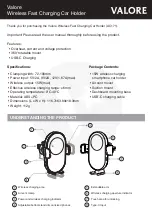
Installation & Operation Manual Merlin Gas Detector
Rev: 18 03-20
8
Other gases and substances to avoid; Corrosives (i.e. chlorine & hydrogen chloride); Alkali
metals; Basic or acidic compounds; Silicones; Tetraethyl lead; Halogens and halogenated
compounds.
A detector may visually appear in good order, but its sensitivity can be inhibited by external
factors. Regular ‘bump tests’ are important to make sure the detector is able to detect a
release of gas as early as possible.
A ‘bump test’ takes seconds and is often completed
alongside a scheduled fire alarm test. We recommend this is done at least weekly to reduce
the risk of a detector not performing, however the frequency should be determined from a risk
assessment by the end user.
Bump Testing
What is bump testing?
‘Bump testing’ is a term used for checking a gas detector is functioning correctly by exposing it
to the target gas. A known concentration of the target gas is applied to the sensor to trigger an
alarm condition and ascertain the detector is working safely.
Why is it important?
A detector may visually appear in good order, but its sensitivity can be inhibited by external
factors. Dust, humidity, temperature fluctuations, cleaning products, contaminants or sensor
drift (ageing) can cause a decline in sensitivity and eventual failure. Regular ‘bump tests’ are
important to make sure the detector is able to detect a release of gas as early as possible.
How often?
A ‘bump test’ takes seconds and is often completed alongside a scheduled fire alarm test.
Current British standards recommend that for new installations - it may be prudent to carry out
a bump test frequently (perhaps weekly), following a successful initial period and as
confidence grows in the installation concerned, the frequency could be reduced.
Please remember, ‘bump testing’ does not remove the need to have gas detectors inspected,
calibrated and serviced periodically by a trained engineer.
For more help and advice on bump testing, calibration and service – contact us.
End of Life
The expected lifecycle will depend on the type of gas your detector is targeting and may vary
depending on environmental conditions.
Natural Gas /Methane: 10 Years
Liquid Petroleum Gas: 10 Years
Hydrogen: 10 Years
Carbon Monoxide: 5 Years
At the end of this time, contact your supplier and replace the unit immediately.






























